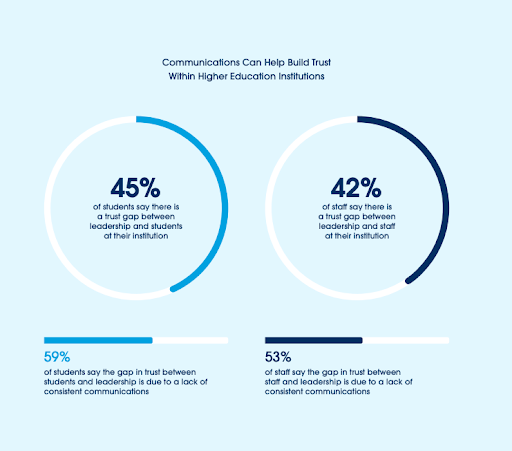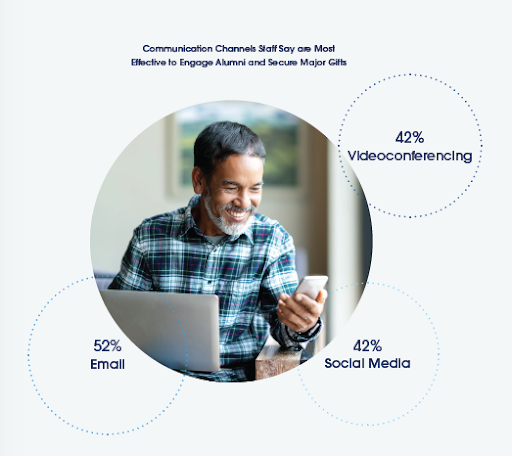Communicating with students, staff, and alumni is a daily task for many at higher education institutions. It happens via multiple channels—email, text messaging, social media, and, in the case of advancement communications, even snail mail. But how do you know what’s working and what isn’t? Are your messages getting through to the right people at the right time? And how are your communications supporting all constituents including students, staff, partners, and alumni?
The second edition of the Connected Student Report, created by Salesforce and the Chronicle of Higher Education, was designed to gain a better understanding of what’s top of mind for students and what they expect throughout their higher education experience. It also connected with staff at higher education institutions to find out how they are engaging learners at each stage of the education journey.
The results clearly highlighted areas of opportunity when it comes to effective communications and marketing. Based on the report findings, here are six ways you can communicate better with your constituencies:
1. Be consistent
If you’re not communicating consistently, how will people trust that they’re receiving the right information at the right time? The second edition of the Connected Student Report found that more than half (59%) of students attributed a trust gap between leadership and students to a lack of consistent communication. Similarly, 53% of staff said a lack of communication led to a trust gap between themselves and leadership.

Creating and disseminating consistent communications requires planning, tracking, and effective execution. The communications team at Indiana University noticed that several units and schools across the institution were sending unbranded or inconsistent emails every day using more than 400 email solution instances. To better coordinate and personalize communications, they moved to a single instance powered by Salesforce’s Marketing Cloud. The move has strengthened and unified the university’s brand identity and helped improve targeting.
2. Reach out more often
A vast majority (9 in 10) of students surveyed said they want their colleges to communicate with them the same amount or more via email, personalized communications, and reminders/alerts. So how do you do this? The key is to make it easy. Stop dealing with outdated mailing lists or data management systems that take more time to maintain than to actually use. Invest in systems that simplify data aggregation and create processes that empower employees to use data to personalize experiences.
An outstanding example of this is Texas Tech University, which was able to increase the volume of its digital communications by a stunning 200% by switching to Salesforce to manage its data. During the COVID-19 pandemic, having that technology already in place helped the university communicate quickly and efficiently with students, parents, staff, and faculty as the situation changed rapidly.
3. Make it personal
When asked how their university could improve existing communications, 42% of students said they wanted more personalization. Achieving this requires knowing your audience to the greatest possible degree. For marketers, this means having information at your fingertips.
When Arizona State University merged all its email systems into Salesforce to better communicate with prospective and current students, alumni, and even parents. The shift completely transformed the way they communicate. Using Marketing Cloud, staff can now easily access all available information about a given recipient and send them only the communications that are relevant to their needs and situation.

4. Build trusted relationships
These days, alumni want to know how and where the money they donate is being used and who it benefits. A full 43% of advancement staff said they have increased their communications about the impact of their fundraising efforts, building trust with donors and potential donors by offering transparency and sharing stories. Staff also highlighted that email is the most effective channel for securing major gifts with videoconferencing and social media landing in second place.
UCSF is creating a donor journey that will focus on quickly letting new donors know how their gifts impact the university, strengthening the school’s connection to its alumni and increasing the potential for future giving. The university uses Marketing Cloud to manage their alumni database, making it simple to reach out as soon as a donor’s gift is allocated.
5. Build connections
Most of the students surveyed said they only feel somewhat (34%) or slightly connected (39%) to their university’s alumni network. Thirty-six percent said they don’t know how to connect with alumni, and 35% said there is no internal system at their institution that can help them connect with alumni working in a career they’re interested in.
Since networking is essential to securing a job post-graduation, students need and value connections to alumni employed in similar fields. Making it easier for them to make those connections can be as simple as leveraging the power of a CRM like Salesforce to match interested alumni to potential corporations or mentors. Another option would be to build tailored marketing journeys that spotlight alumni in specific fields and offer a simple way to connect to learn more about their experiences.
6. Make it rewarding
From airlines to grocery stores and hotel groups, everyone offers a loyalty program with tailored communications playing an essential role. So why not reward alumni who donate or volunteer with some great perks? School-branded clothing, invitations to special lectures, dinners with prominent figures, tickets to sporting or arts events—the possibilities are endless.
Download the Connected Student Report
The second edition of the Connected Student Report surveyed 1,128 students and 1,076 staff members from 10 countries. Get insights into how students and staff feel about the higher education experience.































